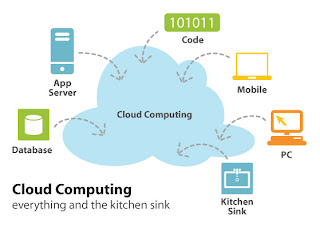
QUESTIONS
What is cloud computing?
What are the differences between cloud computing, web2.0 and the internet?
EVOLUTION – TECHNICAL AND FINANCIAL
Prerequisite: Cheap broadband
Software as a service (SaaS): remotely accessing software from someone elses data centre using a web browser
Virtualisation: initially apps were difficult to deploy but then came virtualisation, the packaging of applications with everything else they need to run. Virtual apps can run anywhere (ie. in the cloud)
Financial model is PAYG, more economical than alternatives
This video explains the basic concepts:
THE NETWORK WILL EAT THE PC
... data management and computational processing is moving away from personal computing frameworks into a collaborative workspace that is managed in the network
- Cloud computing, Science2.0 and the Social Web
INEVITABLE TREND
It is an inevitable trend in computing, because of the need to reduce complexity and data-management/computation-management costs. It's clear that, in the near future, the backup storage and computation will continue to evolve into collaborative workspaces that you never have to administer
- Cloud computing, Science2.0 and the Social Web
HELPFUL METAPHORS AND EXPLANATION
from http://www.youtube.com/watch?v=6PNuQHUiV3Q:
Dan Farber, Editor and Chief CNET News:
We currently have three platforms: the desktop, mobile devices and the cloud ... increasingly things will start to lean towards the cloud ... when there is enough bandwidth, reliability, security and so on then there will no longer be a notion of a cloud ...it will be just like serving up electricity, serving up data, applications and even writing those applications directly to the cloudTim O'Reilly, quoting from a Clay Shirky presentation:
Thomas Watson once famously said (allegedly) that there is no need for more than five computers in the world
We now know that he was wrong
He overstated the number by four!
Everything we think of as a computer today is just a device for connecting to this one big computer that we are all building
EXAMPLES
Google docs
Zoho: It includes tools for word processing, spreadsheets, presentations, databases, note-taking, wikis, CRM, project management, invoicing and other applications
SOME OF THE CONCEPTS DEFINED
Software as a Service
Software as a Service (SaaS, typically pronounced 'sass') is a model of software deployment whereby a provider licenses an application to customers for use as a service on demand
Virtualisation
Virtualization is the creation of a virtual (rather than actual) version of something, such as an operating system, a server, a storage device or network resources
Utility Computing
Utility computing is the packaging of computing resources, such as computation and storage, as a metered service similar to a traditional public utility (such as electricity, water, natural gas, or telephone network). This system has the advantage of a low or no initial cost to acquire hardware; instead, computational resources are essentially rented. Customers with very large computations or a sudden peak in demand can also avoid the delays that would result from physically acquiring and assembling a large number of computers
(traced back to a john mccarthy, 1961 quotation)
http://en.wikipedia.org/wiki/Utility_computing
Grid computing
The application of several computers to a single problem at the same time – usually to a scientific or technical problem that requires a great number of computer processing cycles or access to large amounts of data.
No comments:
Post a Comment